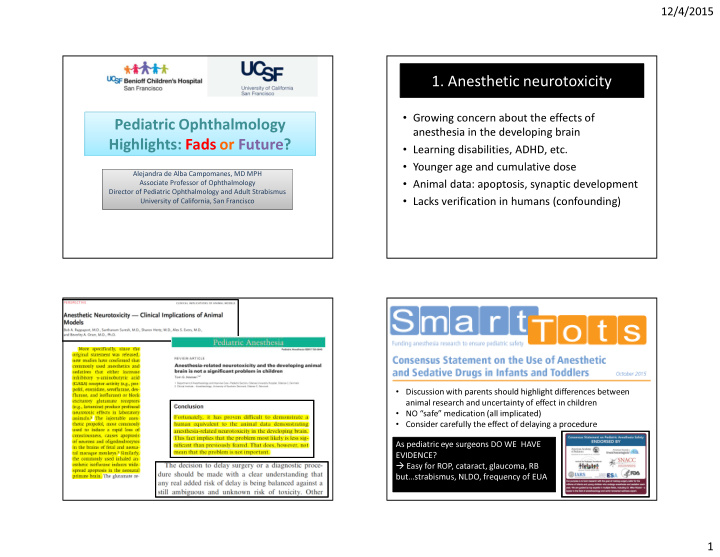



12/4/2015 1. Anesthetic neurotoxicity • Growing concern about the effects of Pediatric Ophthalmology anesthesia in the developing brain Highlights: Fads or Future? • Learning disabilities, ADHD, etc. • Younger age and cumulative dose Alejandra de Alba Campomanes, MD MPH • Animal data: apoptosis, synaptic development Associate Professor of Ophthalmology Director of Pediatric Ophthalmology and Adult Strabismus • Lacks verification in humans (confounding) University of California, San Francisco • Discussion with parents should highlight differences between animal research and uncertainty of effect in children • NO “safe” medication (all implicated) • Consider carefully the effect of delaying a procedure As pediatric eye surgeons DO WE HAVE EVIDENCE? � Easy for ROP, cataract, glaucoma, RB but…strabismus, NLDO, frequency of EUA 1
12/4/2015 Anesthetic neurotoxicity • …while the concern is a FAD… • Whether real or not, we will be hearing a lot more about this • Efforts to minimize exposure among pediatric surgeons will increase • “the seed of doubt has been planted” Icare rebound tonometer 2
12/4/2015 2. VEGF blockers for ROP • BEAT-ROP 2011 • FDA approved since 2007 and endorsed by the AAO in 2013 as accurate way of measure IOP 6% 42% 5% 12% in children <18 (normal and glaucoma) • DOES NOT REQUIRE TOPICAL ANESTHESIA • Good GAT correlation (+2-3 mmHg) • Solid P: +/- 1.8 mmHg SD – flashing P -- indicates higher SD (>3.5mmHg) Less myopia Late recurrence concern with IVB Bevacizumab Laser 1 year JAMA Ophthal, June 2012 3
12/4/2015 8/06/2013 -9.50 +1.00 x 065 OD -7.50 +1.00 x 110 OS Systemic absorption Which anti-VEGF? Ranibizumab Bevacizumab Molecular weight 48 KDa 149 KDa Intravitreal half-life 2.88 days (0.5mg) 4.32 days (1.25 mg) Serum half-life 2 hours 20 days (60 days) * Decrease Serum VEGF 1-3 weeks 7+ weeks 15% 60% Cost $1,986.29 $64.62 **All patients had received LASER Regulatory Not FDA approved for ROP Not FDA approved for ROP Has only RCT T Sato, Am J Ophthal, 2011 *Lee S . IOVS 2011;52:ARVO E-abstract 3165 4
12/4/2015 Ranibizumab appears safer Pre-injection 40 days after Lucentis injection Post-injection 5
12/4/2015 IVRani vs. IVBeva • Chen 2015 (Retina): 72 eyes, no difference • Wong 2015 (Retina):83% (5/6) vs. O% reactivation • Baumal 2015 (OSLIR): 100% reactivation (8/8) • Bedda 2014: 12.5% recurrence rate • Jang 2010: Bilateral RD 1 month after full regression • Zhou 2014: 45% recurrence (10/22) • De Alba/Rivera (WOC 2016): 100% recurrence (7/7) 3. Oral levodopa for amblyopia VEGF blockers for ROP • Despite lack of long term and safety studies • Started as treatment in 1995 • “the horse is out of the barn” • No evidence that there is a deficiency in the brain in children with amblyopia • Dopamine plays a role in retinal function and central visual processing (Brandies et al 2008) • Several studies show some improvement in • We will see (hopefully) more information vision (1.1 log) as initial treatment for about optimal VEGF agent, combined amblyopia treatments and guidelines for follow-up 6
12/4/2015 • RCT, placebo controlled, as adjunctive treatment to patching in children 7-12 yo with VA 20/50-400 • Strabismic or anisometropic amblyopia • Dose 0.76 mg/kg levo/carbidopa TID +patching for 16 weeks LEVODOPA/PLACEBO STOPPED 7
12/4/2015 Dopamine for amblyopia 4. Atropine to halt myopia progression • Need to expand our armamentarium for the treatment of amblyopia “the myopia epidemic” 8
12/4/2015 Interventions to retard myopic progression • Muscarinic antagonists – ATROPINE , Pirenzepine • Progressive addition lenses (PALs) • Orthokeratology • Bifocal glasses • Bifocal soft contact lenses • Environmental interventions • Combinations Atropine • Night topical atropine 1% • Slows progression of low and moderate myopia and axial elongation • Placebo eyes progressed -1.20 D (±0.69) • Treated eyes progressed -0.38 D (±0.92) • After treatment is stopped, treated eyes had a higher rate of myopic progression Chua et al. Ophthalmology 2006;113:2285-2291 Tong et al. Ophthalmology 2009; 116:572-579 9
12/4/2015 Low dose Atropine Atropine to halt myopia progression • ATOM 1 (atropine for the treatment of myopia) • ATOM 2: compared 0.01% vs. 0.1% vs. 0.5% – Dose response in progression in first 2 years – Higher dose faster effect, lower dose takes 8-24m – Higher rebound effect in higher doses, almost none in lower doses – Dilation and accommodation minimally affected by 0.01% – Decreases myopia progression by 50% (0.5 vs. 1 D/yr) – 10% do not respond – Need to slow taper Thank you! dealbaa@vision.ucsf.edu 10
12/4/2015 5. Telemedicine for ROP Telemedicine for ROP • Potential to expand the evaluation and management options available for ROP surveillance. • Combination of factors has fueled interest in TM: – Scarcity of qualified ophthalmologists willing to provide screening – Complex coordination of services and tracking – Inadequate reimbursement – Decentralization of neonatal care to community hospitals • Barriers: variability in image interpretation, insufficient evidence, high implementation cost Telemedicine for ROP • Systematic review 11 studies (total of 486 references) • Level I evidence that telemedicine is accurate – Sensitivity 76*-100% (*outlier 57%) – Specificity 87*-97% (*outlier 37%) • Not more harmful or stressful that indirect ophthalmoscopy 11
12/4/2015 Retcam Plus disease Retcam Plus disease Telemedicine for ROP • Useful adjunct but not replacement of ophthalmoscopy • “the pace of implementation of TM for ROP evaluation in the ophthalmic community has outstripped the pace of systematic evaluation of the approach.” • Need to define roles, protocols, training • Expand on the available technology (smart phones?) 12
Recommend
More recommend